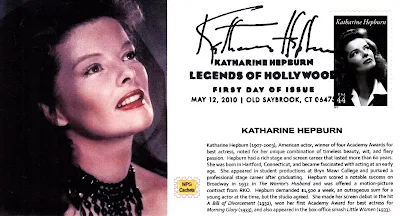USPS on 12 May 2010 issued another Legends of Hollywood stamp, honouring this time actress Katharine Hepburn. The cancellation postm,ark originated from Old Saybrook, Connecticut.
Katharine Houghton Hepburn was born on 12 May 1907 in Hartford, Connecticut.From a young age, Hepburn’s parents encouraged her to be outspoken and develop both her body and mind. Following her brother’s suicide in 1921, Hepburn fell in a debilitating depression for several years. For much of her career, she claimed his birthday (8 November) as her own. Hepburn eventually overcame the tragedy and attended Bryn Mawr College near Philadelphia, Pennsylvania. While there, she was suspended for breaking curfew and smoking. (She later confessed she also swam naked in the college’s fountain.) Hepburn wore slacks long before they became fashionable, disliked makeup, and often refused to sign autographs. Unconventional behavior became her hallmark.
It was also at Bryn Mawr that Hepburn discovered her love of acting. During her senior year she claimed the lead role in "The Woman in the Moon". The positive reviews she received convinced her that acting was her future. After graduating with a degree in history and philosophy, Hepburn went to New York where she appeared in a number of plays on and off Broadway. After moderate success on the stage, Hepburn was cast in "The Warrior’s Husband". She received excellent reviews, including one from the New York World-Telegram stating, “It’s been many a night since so glowing a performance has brightened the Broadway scene.”
A Hollywood agent also happened to catch her performance and recommended her for the upcoming RKO film, A Bill of Divorcement. Hepburn demanded $1,500 a week, a high amount for an unknown actress. But the director was so impressed with her that he encouraged the studio to take a chance.
Hepburn met actor Spencer Tracy in 1942 during the filming of "Woman of the Year", and the pair quickly became one of Hollywood’s most recognisable couples. Tracy and Hepburn appeared in nine films together, including classics such as "Adam’s Rib" and "Guess Who’s Coming to Dinner". Hepburn even took a break in her acting career to care for Tracy in his final years.
Hepburn continued to act into the 1990s, though her health began to decline. She died on 29 June 2003, in the house where she grew up 96 years earlier. Over the course of her career, Hepburn won a record four Academy Awards and was named the greatest female star in the history of American cinema by the American Film Institute.
It was also at Bryn Mawr that Hepburn discovered her love of acting. During her senior year she claimed the lead role in "The Woman in the Moon". The positive reviews she received convinced her that acting was her future. After graduating with a degree in history and philosophy, Hepburn went to New York where she appeared in a number of plays on and off Broadway. After moderate success on the stage, Hepburn was cast in "The Warrior’s Husband". She received excellent reviews, including one from the New York World-Telegram stating, “It’s been many a night since so glowing a performance has brightened the Broadway scene.”
A Hollywood agent also happened to catch her performance and recommended her for the upcoming RKO film, A Bill of Divorcement. Hepburn demanded $1,500 a week, a high amount for an unknown actress. But the director was so impressed with her that he encouraged the studio to take a chance.
Hepburn met actor Spencer Tracy in 1942 during the filming of "Woman of the Year", and the pair quickly became one of Hollywood’s most recognisable couples. Tracy and Hepburn appeared in nine films together, including classics such as "Adam’s Rib" and "Guess Who’s Coming to Dinner". Hepburn even took a break in her acting career to care for Tracy in his final years.
Hepburn continued to act into the 1990s, though her health began to decline. She died on 29 June 2003, in the house where she grew up 96 years earlier. Over the course of her career, Hepburn won a record four Academy Awards and was named the greatest female star in the history of American cinema by the American Film Institute.

No comments:
Post a Comment